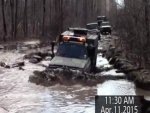The -10 tm says 16" is OK, and don't go over 20". Fording 20" or more requires changing oil in everything and a full chassis lube. I read the -20 and -34 TMs looking for details on "post fording" maintenance, but found nothing further. Is there another TM that addresses these things?
The images below are from a CUCV that evidently stalled while fording deep water at Rausch Creek this weekend.


He later reported that his engine "blew" on the way home.
http://www.steelsoldiers.com/showth...2015-Rausch-Creek-Steel-Soldiers-Rally/page18
Those images are from 17:07 and 17:25 of this video:
www.youtube.com/watch?v=ppkn-nRiV-8.
In the videos another CUCV had a deuce tow him through the deep water with his engine off. I'm sure that he ingested less water that way, but I'd be worried that I'd ingested enough water to cause problems later.
I understand that a CUCV is far less capable than a deuce, especially a deuce rigged for fording. I can own a CUCV and stay married. That wouldn't be possible if I owned a deuce. I want to make my truck as capable as possible, and I want to learn to drive it off road within those capabilities, but I don't have any delusions that it will be as capable as a deuce.
I ordered a pair of chest waders for the M1010, so I can go find out how deep the water is before I drive into it. I figure I'll mark lines at 16 and 20" on the waders, and use that to figure out when to proceed and when to turn back.
I normally keep a gallon of engine oil in the truck for road trips. For off-road trips, I'll be adding another gallon and a drain pan and filter, so I can change the oil if I mess up and end up in water that's too deep. I'll also need to add the materials for re-packing hubs, chassis lube, and changing the oil in the transmission, transfer case, and axles. Post-fording maintenance is starting to seem like quite a project. I guess that will motivate me to use the hip waders before fording, and to stay out of deep water.




